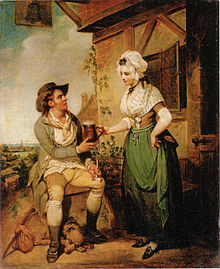|
Parish aleThe Parish ale or church ale is a party or festivity in an English parish at which ale is the chief drink. It is typically a fundraising occasion for the parish that might include music and dancing. Very common in the later Middle Ages, parish ales encountered some opposition after the English Reformation, some have survived into modern times in some form. In 2025, this form of fundraising is planned to take place at the church of St. Helen's in Colne[1].  TypesThe word "ale", in the sense of an ale-drinking party, was part of many compound terms for types of party or festivity based on the consumption of ale or beer. Thus there was the leet-ale (held on "leet", the manorial court day); the lamb-ale (held at lamb-shearing); the Whitsun-ale (held at Whitsun), the clerk-ale, the church-ale etc. The word "bridal" originally derives from bride-ale, the wedding feast organised to raise money for the couple.[2] The bid-ale, once very common throughout England, was a benefit feast to which a general invitation was given, and all those attending were expected to make some contribution to help the object of the benefit, usually a poor person or family or some other charitable cause.[3] Morris dancing used to be common entertainment at parish ales, and a meeting of Morris dancers today is still called a Morris Ale.[4] SignificanceThese parish festivals were of much ecclesiastical and social importance in medieval England. The chief purpose of the church-ale (which was originally instituted to honour the church saint) and the clerk-ale, was to facilitate the collection of parish dues and to make a profit for the church from the sale of ale by the church wardens.[5] These profits kept the parish church in repair, or were distributed as alms to the poor.
In the gallery of the tower arch of St Agnes, Cawston in Norfolk is inscribed:
On the beam of a screen in the church of Thorpe-le-Soken, Essex, is the following inscription in raised blackletter on a scroll held by two angels: "This cost is the bachelers made by ales thesn be ther med." The date is about 1480. DescriptionThe feast was usually held in a barn near the church or in the churchyard. In Tudor times church-ales were held on Sundays; gradually the parish-ales were limited to the Whitsun season, and these still have local survivals. The colleges of the universities used to brew their own ales and hold festivals known as college-ales; some of these ales are still brewed and famous, like "chancellor" at Queen's College, and "archdeacon" at Merton College, Oxford, and "audit ale" at Trinity, Cambridge. A short piece printed in the Manchester Times in 1870 quoted from Jefferson's Book about the Clergy:
See also
References
|
Portal di Ensiklopedia Dunia